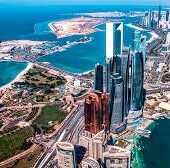Abu Dhabi Grand Prix 2025 Experience: 4 Nights from R41 466 PPS - 04 Dec - 08 Dec 25

When can I go?
04 Dec 2025 – 08 Dec 2025
Book by 15 Nov 2025
Description
The Abu Dhabi Grand Prix 2025 promises an electrifying experience for motorsport enthusiasts and everyone. As the thrilling conclusion to the Formula 1 season, this prestigious event combines heart-pounding racing action with Abu Dhabi’s unparalleled luxury and cultural heritage. This is more than just a race; it’s a celebration of speed, sophistication, and the spirit of Abu Dhabi. Don’t miss it!
TH#185948
What’s included in the deal?
- 4 Night stay at the 4* City Seasons Al Hamra Hotel (or similar) in a Premium room
- Breakfast daily
- Tourist Visa
- 3 Day West Straight Premium ticket with Friday, Saturday and Sunday access
– Seated together & numbered seats
– The best, most central seats on the West Straight Grandstand
– Giant screen views
– Oases area access
– Admission to evening concerts
– 1 Day access to one theme park on Yas Island
– Access to the Pit Lane Walk on Thursday
Package Excludes:
Flights, airport taxes, transfers, travel insurance, medical insurance, meals and drinks not mentioned or any items of a personal nature.
**Call us to enquire about the best available flight options**
Terms & Conditions
Grand prix tickets valid for the 05 – 07 December 2025
Prices are based on a from price, per person sharing, subject to availability and currency fluctuation for international holidays. The exact amount will be confirmed at the time of booking. High season surcharges, block out periods and minimum stay conditions may apply. Group rates available on request..
Formula 1® racing began in 1950 and is the world’s most prestigious motor racing competition, as well as the world’s most popular annual sporting series: The Formula One World Championship™ runs from March to December and spans 21 races in 21 countries across four continents.
Enjoy the rush and Adrenaline as the cars fly past you on the track, take in the sight and speeds of this amazing world-renowned race.
Why we love the Grandprix
– Pinnacle of Motorsport
-Cutting edge technology on the track
-The emotions and passion behind the race and the drivers
-F1 prestige and the heroes it creates, the cars that are the gladiators
United Arab Emirates
The United Arab Emirates, in the eastern part of the Arabian Peninsula, extends along part of the Gulf of Oman and the southern coast of the Persian Gulf. The nation is the size of Maine. Its neighbors are Saudi Arabia to the west and south, Qatar to the north, and Oman to the east. Most of the land is barren and sandy.
Federation formed in 1971 by seven emirates known as the Trucial States—Abu Dhabi (the largest), Dubai, Sharjah, Ajman, Fujairah, Ras al-Khaimah, and Umm al-Qaiwain. In addition to a federal president and prime minister, each emirate has a separate ruler who oversees the local government.
HISTORY
Originally the United Arab Emirates was inhabited by a seafaring people who were converted to Islam in the 7th century. Later, a dissident sect, the Carmathians, established a powerful sheikdom, and its army conquered Mecca. After the sheikdom disintegrated, its people became pirates. Threatening the Sultanate of Muscat and Oman early in the 19th century, the pirates provoked the intervention of the British, who in 1820 enforced a partial truce and in 1853 a permanent truce. Thus, what had been called the Pirate Coast was renamed the Trucial Coast. The British provided the nine Trucial states with protection but did not formally administer them as a colony.
The British withdrew from the Persian Gulf in 1971, and the Trucial states became a federation called the United Arab Emirates (UAE). Two of the Trucial states, Bahrain and Oman, chose not to join the federation, reducing the number of states to seven.
The country signed a military defense agreement with the U.S. in 1994 and one with France in 1995.
After the Sept. 11 terrorist attacks on the U.S., the UAE was identified as a major financial center used by al-Qaeda in transferring money to the hijackers (two of the 9/11 hijackers were UAE citizens). The nation immediately cooperated with the U.S., freezing accounts tied to suspected terrorists and strongly clamping down on money laundering.
Sheikh Zayed bin Sultan Al Nahyan, the founder of the UAE and ruler of the federation since 1971, died in Nov. 2004. His son succeeded him. In Jan. 2006, Sheik Maktoum bin Rashid Al Maktoum, the prime minister of the UAE and the emir of Dubai, died. Crown Prince Sheikh Muhammad ibn Rashid al-Maktoum assumed both roles.
The Burj Khalifa, in Dubai, was completed in January 2010 and became the world’s tallest building at 2,716 feet (828 meters) and 160 stories. It contains the world’s fastest elevators, 20.7 acres of glass, and is expected to use about 250,000 gallons of water per day
LANGUAGE
Arabic (official), Persian, English, Hindi, Urdu
CULTURE
Ethnicity/race: Emiri 19%, other Arab and Iranian 23%, South Asian 50%, other expatriates (includes Westerners and East Asians) 8% (1982)
Religions: Muslim (Islam; official) 76%, Christian 9%, other (primarily Hindu and Buddhist, less than 5% of the population consists of Parsi, Baha’i, Druze, Sikh, Ahmadi, Ismaili, Dawoodi Bohra Muslim, and Jewish) 15%. Note: represents the total population; about 85% of the population consists of noncitizens (2005 est.)
CLIMATE
The climate of the UAE is subtropical-arid with hot summers and warm winters. The hottest months are July and August, when average maximum temperatures reach above 45 °C (113 °F) on the coastal plain. In the Al Hajar Mountains, temperatures are considerably lower, a result of increased elevation. Average minimum temperatures in January and February are between 10 and 14 °C (50 and 57 °F). During the late summer months, a humid southeastern wind known as Sharqi (i.e. “Easterner”) makes the coastal region especially unpleasant. The average annual rainfall in the coastal area is less than 120 mm (4.7 in), but in some mountainous areas annual rainfall often reaches 350 mm (13.8 in). Rain in the coastal region falls in short, torrential bursts during the summer months, sometimes resulting in floods in ordinarily dry wadi beds. The region is prone to occasional, violent dust storms, which can severely reduce visibility.
In 2004, there was snow in the UAE for the very first time, in some of the higher-altitude parts of the country. A few years later, there were more sightings of snow and hail. The Jebel Jais mountain cluster in Ras al-Khaimah has experienced snow only twice since records began.
ECONOMY
UAE has the second largest economy in the GCC (after Saudi Arabia), with a gross domestic product (GDP) of $377 billion (1.38 trillion AED) in 2012. Since independence in 1971, UAE’s economy has grown by nearly 231 times to 1.45 trillion AED in 2013. The non-oil trade has grown to 1.2 trillion AED, a growth by around 28 times from 1981 to 2012. UAE is ranked as the 26th best nation in the world for doing business based on its economy and regulatory environment, ranked by the Doing Business 2017 Report published by the World Bank Group.
WHAT TO PACK
Summer Clothing to Pack for Dubai
While Dubai is a relaxed city when it comes to foreigners, it’s still a good idea to dress modestly. When in the city and off the beaches, wear loose clothing that covers your arms and legs, especially if you wish to enter a mosque or nice restaurant.
Dubai is a hot and humid desert city along the shores of the Persian Gulf. During the summer, temperatures can often reach over 100 degrees. Late May to October are the hottest months, so you will want to pack items that prevent sunburn, such as sunscreen, hats, sunglasses, and lip balm. Sandals are needed to keep your feet from burning on beach sand. These items can also be purchased in Dubai. Bring a few swimsuits to play at the beach, the hotel pools and the local water parks. Bringing a waterproof camera to capture these fun, wet days in Dubai is highly recommended. Clothing should be light colored to deflect the sun’s rays. A sun umbrella also works well to keep the sun off your head.
Winter Clothing to Pack for Dubai
The desert can get cold at night in the winter from December through February so it’s a good idea to pack a light jacket or sweater. For women, also pack a Pashima, or shawl, to wrap around you for warmth and modest fashion. For the daytime, pack as you would for the summer months as Dubai is hot and humid year round though the winters are more mild.
Other Things to Pack for Dubai
To combat the dry air of the Dubai desert, pack moisturizer and use it a couple of times a day, especially after a shower. A small, portable fan or an inexpensive Chinese folding fan will help get you through some of the hotter days. There are many opportunities to hike the Arabian sands of Dubai, so also be sure to pack hiking boots designed for Dubai’s climate. A small backpack to hold your water, an extra pair of clothing and other essential items for Dubai day trips is another good item to bring. Because of the high humidity, clothing takes longer to dry, therefore you may want to pack extra underwear and socks to avoid an unnecessary shopping trip for more.





